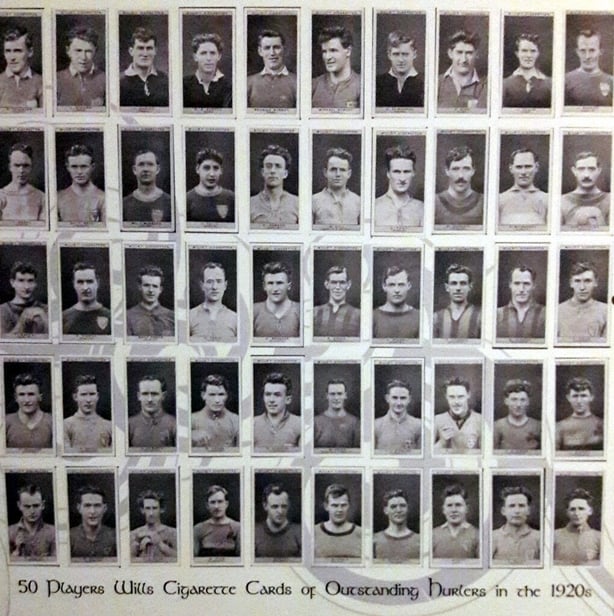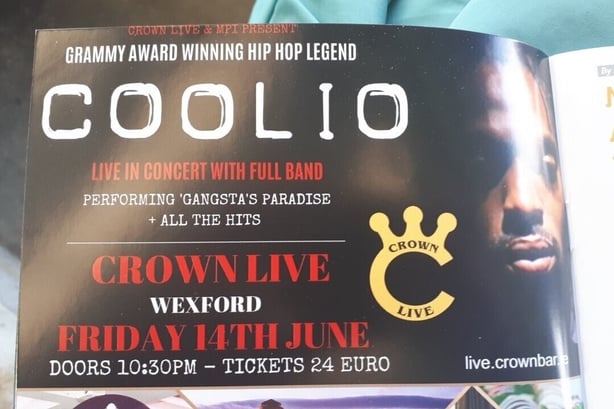Analysis: the brands and products who've used GAA stars and events to flog their wares has evolved hugely over the years
GAA events and GAA stars have been increasingly valued as a way for all sorts of products and services, including those not related to GAA at all, to be sold to consumers. From traditional print advertising and partnerships with tobacco companies to billboards and online campaigns, here are examples of how GAA advertising has evolved over the years.
Hundreds of millions of collector's cards were issued globally, usually with packets of cigarettes from the late 19th century. The cards featured a wide array of topics including military history, nature and geography. In the 1920s, Will’s cigarettes issued a series of cards that featured hurlers and footballers with portraits on the front and a short biography on the back. It was hoped that the cards would build brand loyalty as smokers collected the entire series.

The tobacco trade was an important source of income for the GAA and there were many collaborations including the Sweet Afton cup, given to the winners of the Munster intermediate hurling championship and the PJ Carroll’s All-Star awards, which were launched in 1971. At GAA Congress in 1977, a motion to abolish advertising of alcohol and tobacco at GAA grounds was heavily defeated, indicating the reliance upon income from such sponsorships. The GAA has since reappraised its attitude to sponsorship and alliance with tobacco companies and cut all ties in favour of encouraging the creation of tobacco free GAA grounds to positively impact upon smoking behaviour.
As GAA players are particularly prominent in Irish media, it has led to some questionable collaboration with players, including Kerry footballer Pat Spillane endorsing cattle feed Tendrleen. This collaboration would perhaps be more appropriate if he were an experienced farmer and not a primary school teacher. In 2015, Second Captains revisited some other agriculture-based advertisements, such as Tipperary's Bobby Ryan encouraging farmers to pick up some Zerofen to "wipe out worms before worms wipe out your profits"
From RTÉ One's Second Captains, "cattle worming products were the Pepsi and Nike of 1980s and 1990s' Ireland"
Match day programmes are an outlet for advertising whi ch many musicians have tapped into. In 1984, the Wolfe Tones promoted their albums in the All-Ireland football final programme. That year, the final between Dublin and Kerry took place in Thurles as part of the GAA's centenary celebrations, as did the hurling final. Local Tipperary legends the Clancy Brothers and Armagh's Tommy Makem made the most of the captive audience by promoting their reunion tour in a full page spread.
In 2019, the late US rapper Coolio advertised an upcoming gig in The Crown Live in the match day programme for a Wexford championship double header. Power and the money, money and power of match day programmes.

In 2003, Wexford's Damien Fitzhenry and Paul Codd and Cork's Seán Óg Ó Hailpín used hurleys branded with a Paddy Power stamp on them during an All-Ireland hurling semi-final. They were each reportedly paid €750 by the bookmarking firm but they breached GAA guidelines on playing gear in doing so. The three players avoided a ban as they lined out six days later in a replay, which Cork won. The debacle caused quite a stir and GAA president Sean Kelly even called for Paddy Power to vacate their corporate box in Croke Park.
The GAA has proud traditions and heritage, but there is also a need to fund the high level of experience that the games now demand. This involved the association making a controversial deal with Sky Sports in 2014, allowing the UK satellite broadcaster exclusive rights to screen live Championship games during the summer, leaving many fans without access to some of the biggest matches of the year. The broadcast deal was terminated by "mutual agreement" in October 2022. Stadium sponsorship has also become a growing trend in GAA, with the names of many county grounds now being prefaced with the name of a corporate sponsor.
Down the pitchforks. The Ladyball isn't coming to a store near you anytime soon -https://t.co/CY0K2Q36i2 #rtegaa #Ladyball
— RTÉ GAA (@RTEgaa) January 15, 2016
In 2016, Lidl and the LGFA pulled off an advertising stunt that drew criticism for the way it appeared to make light of women in sport. The multi-platform Ladyball campaign claimed to be in support of the launch of a new pink ball aimed at women that was "specifically designed for a lady's game" and among its supposed features were a "soft touch - for a woman's grip" and a "fashion driven design". However, three days later, Lidl and the LGFA confessed that Ladyball was a stunt and later launched the Serious Support campaign which raises awareness of the difficulties female sports persons have in getting the same recognition as their male counterparts.
Ladyball was perhaps a response to a 2011 advertising campaign which objectified women in sport and caused widespread controversy. Ireland’s advertising watchdog uphold 82 complaints made against an advertising campaign for Hunky Dory's crisps which featured scantily-clad women posing suggestively as Gaelic footballers. The advertisements appeared as full-page and double-page ads in newspapers, as well as on billboards and online.
The CEO of the company which manufactured Hunky Dorys later defended the ad campaign, saying that as a medium-sized Irish company "we have to attract attention one way or other". While successful in attracting the public’s attention, the campaign ridiculed women’s role in sport by showing exploitative images and in doing so, consumed valuable space in the media in the week leading up to the camogie All-Ireland finals.
A selection of Guinness hurling ads
As a longstanding GAA sponsor, Guinness has provided many innovative advertisements that have doubled up as short forms of entertainment. The 'Believe' campaign showed a player standing over a last minute free to win a final and is seemingly inspired by the alcoholic drink. Other advertisements include a profile of GAA volunteers, hurlers Dan Shanahan and Joe Deane showing off their skills and a scramble for All-Ireland tickets which saw a man turn to the shady world of American gangsters.
In 2008, Guinness brought hurling off the pitch and into specially built 3D Perspex cubes for a 3-a-side hurling game. Kilkenny Castle hosted the Guinness Hurling Cubed competition for three nights, which was endorsed by All-Star hurlers. Played with 21" hurls and a soft touch sliotar, the game was developed by Guinness, with expert guidance from former Cork manager, Donal O'Grady. Teams of three players competed for either three minutes, or until three goals were scored, with the four semi-finalists winning a trip to Dublin on the eve of the GAA All-Ireland hurling final for the grand finale.
The follow up Kerry Bendix ad in the Indo day after Kerry beat Dublin 2-12 to 2-8 in All Ireland #Gaa #SkySportsGAA pic.twitter.com/JstZfiCaXH
— Jerry O'Sullivan (@jerosullivanRK) April 4, 2014
In a not so successful sponsorship campaign, the Dublin footballers did a pre-match photo call at the Guinness brewery ahead of the 1979 All-Ireland football final. The Dublin team were presented with sponsored kit bags and sportswear on a vintage bus with Guinness advertising on which they "hoped to tour the city with the Sam Maguire cup". Kerry won on a score line of 3-13 to 1-8 and the Guinness bus tour was well and truly parked.
High profile tobacco and alcohol partnerships have been consigned to the past, but marketers still apply the lessons and principles introduced in the early years of GAA advertising when creating strategic marketing efforts, often focusing on the unique skills of players. While some supporters hold onto the purity of GAA grassroot traditions and criticise the trend towards commercialism, today’s Gaelic games, stadiums, players and spectator experiences would not be possible without these advertisements, endorsements and sponsorships.
The views expressed here are those of the author and do not represent or reflect the views of RTÉ








